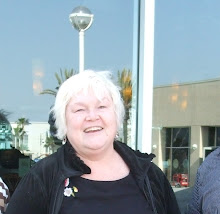
I realized as I put together the “static-dynamic continuum” that I don’t think it is a continuum that I intend to move along at all. I found it is difficult to think of any collaboration that is not dynamic. The very nature of collaboration—as distinct from cooperation where each participant creates a separate part of a whole—means that people have to be in a dynamic situation. Thinking will change as different perspectives are realized and explored. If we are all thinking alike, someone is not thinking.
I also found that content generation that is dynamic may also suffer from being like jello—it looks firm until you poke at it, it disintegrates in heat (translate to criticism), and it is often unsatisfying if you are really hungry. I do not want to “begin to move toward the dynamic end” of content generation completely. I want to be able to see the published version of ideas even when, or especially when, they are wrong or I disagree with them.
Communication is sometimes best when it is not dynamic. Sometimes a school simply needs to get information out to parents; a newsletter or electronic phone call, both static forms of communication, may be the best option. If there is a nut with a gun outside the school, I do not want to discuss it with parents; I want them to stay away and know that their children will not be released to them until it is safe to do so.
I am glad there are ways that classes can operate on the dynamic end of the continuum WHEN IT IS APPROPRIATE. But I do not want revisionist history or weird science to become the norm; I do not want stale, pale male literature to be omitted from curricula. I think we need all the tools and toys to motivate, inspire, and acculturate students in our arsenal to battle ignorance, illiteracy, and lack of motivation.

I responded to http://lkortecc.blogspot.com and http://debrahanks.blogspot.com/
ReplyDeleteYour vision for tool appropriateness is what some dynamic techies lack. Being aware of and finding a use for every new tool is impossible, but being able to seek out potential tools to solve a problem is the possibility. We all work hard, but can you work smarter? Trying to fit the square peg in the round hole is not the problem that needs a solution.
ReplyDeleteThanks for sharing,
~Laurie
Hi Cynthia:
ReplyDeleteI really love your graphic organizer. It is different. My understanding of static technologies is those that are on way; they share knowledge and there is no or little opportunity for others to respond to, share their views or add content. Those that are considered dynamic are the ones, according to Moller (2008) that allow for learners to create knowledge. Therefore, the technology does only provide information, but provides an opportunity for learners to interact with it, build on it, and create content. Taking this into consideration, I think some of technologies that you labeled as dynamic are really static. For example, you mentioned these as dynamic: Websites, e-mails form more knowledgeable others, data bases. Even though these provide content, I do not believe they encourage content building and are therefore considered static. Further, I think Google Docs can be considered a dynamic technology since it is considered a multiuser environment. Several learners get the opportunity to add their thoughts to a document, which can be combined to make a whole. This is a tool that allows for the generation of knowledge.
Soushira
Reference:
Moller, L. (2008). Static and dynamic technological tools. [Unpublished Paper].
Cynthia,
ReplyDeleteI agree with Soushira. Websites and emails are static. They deliver content, sometimes effectively and sometimes not. The collaboration comes in the form of responses to emails or comments on websites, like on sidewikis. The original content stays untouched unless the creator modifies it in the case of websites. Google Docs fosters real time collaboration, somewhat more dynamic than the other tools.
Hello Cynthia,
ReplyDeleteThe music you choose was perfect for the scenes. Watching you video reinforced what I am using for my dissertation. Today’s children are technology based whether they want to or not. The children in your presentation appeared to enjoy using technology. They have more chances available to them than we did growing up. Well put together.